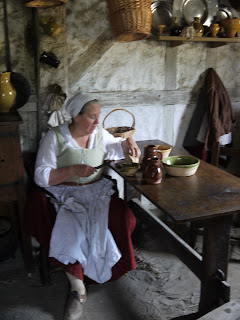 History Lesson Warning: The early Colonists came to America for religious freedom. Roger Williams wanted even more freedom, and that didn't make the Puritans in Boston very happy. He pushed separatism so much, they were going to deport him, but he escaped before he could be arrested. He spent the winter with his friends the Wampanoags, who later deeded to him the land that is now Rhode Island.
History Lesson Warning: The early Colonists came to America for religious freedom. Roger Williams wanted even more freedom, and that didn't make the Puritans in Boston very happy. He pushed separatism so much, they were going to deport him, but he escaped before he could be arrested. He spent the winter with his friends the Wampanoags, who later deeded to him the land that is now Rhode Island. Roger Williams National Memorial is in Providence, RI, where Rogers welcomed refugees from any religion, and his ideas became the basis for the First Amendment to the US Constitution. Besides being an early proponent of the separation of church and state, he championed Native American rights and was even an abolitionist. He organized the first attempt to prohibit slavery in any of the original thirteen colonies. Pretty impressive for a guy who lived 350 years ago!
There's a small parking lot, a small Visitor Center and a small park adjacent to both. In the park, there's a memorial to Gabriel Bernon, a Huguenot who fled persecution in France and settled in Providence. (He's not really buried here--he's buried across the street in the cathedal.)
The Hahn Memorial was erected for Providence's first elected Jewish official. There's a symbolic well at the site of the spring where Rogers gathered the first settlers.
Okay--that's pretty much it for the Rogers Williams NM--good thing we took a little walk around College Hill and took more pictures. Across the street is St. John's Cathedral, which Mr. Bernon helped found as King's Church.
Massachusetts wouldn't allow Baptists, but Williams welcomed them, then founded the first Baptist Church in America in 1638. Nearby is First Baptist Meeting House, the Baptists' third church building in Providence and the oldest in the country.
The Rhode Island School of Design now uses this old house as a museum.The Rhode Island State House is nearby. There's a nice picture of it in the brochure showing the symbolic well in the Hahn Memorial in the foreground. I wanted to get that same picture (which must have been taken a very long time ago!) but the trees have all grown up and are in the way.
Click here for more pictures of Roger Williams NM, including some pretty flowers.



.JPG)
.JPG)


.JPG)

.JPG)





.JPG)


.JPG)




















.JPG)





.JPG)


.JPG)
.JPG)


.JPG)

.JPG)



.JPG)